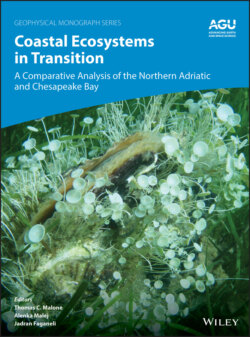Читать книгу Coastal Ecosystems in Transition - Группа авторов - Страница 27
2.1. INTRODUCTION
ОглавлениеIncreasing anthropogenic inputs of nitrogen (N), phosphorus (P), and sediments to the coastal ocean via river discharge over the past 100 years are primary drivers of ecosystem degradation in many estuarine and coastal systems worldwide, including Chesapeake Bay (CB) and the northern Adriatic Sea (NAS) (Degobbis, 1989; Giani et al., 2012; Hagy et al., 2004; Kemp et al., 2005; Murphy et al., 2011; Salvetti et al., 2006; Testa et al., 2014; Zhang et al., 2018). The effects of these inputs include the annual recurrence of seasonal hypoxia, declines in water transparency, habitat loss, and loss of biodiversity (Boesch et al., 2001; Breitburg et al., 2018; Cloern, 2001; Degobbis, 1989; Diaz & Rosenberg, 2008; Giani et al., 2012; Kemp et al., 2005; Testa et al., 2019). Consequently, reducing land‐based inputs of N, P, and sediments have long been a management priority for both CB and the NAS.
In CB, severe bottom‐water hypoxia and loss of submerged aquatic vegetation (SAV) were first evident in the 1950s and 1960s, respectively (Kemp et al., 2005). In subsequent decades, restoration of SAV was a largely uncoordinated voluntary effort. In 1983, the US Environmental Protection Agency (USEPA) signed the first Chesapeake Bay Agreement with four jurisdictions in the bay’s watershed, and the Chesapeake Bay Program was formed to coordinate and facilitate multijurisdictional efforts to restore CB by reducing nutrient and sediment inputs. Subsequent agreements set goals of reducing nutrient inputs by 40% by 2000 and to improve CB water quality sufficiently to remove it from the “dirty waters list” by 2010 (Boesch et al., 2001). Years later, it was realized that this deadline would not be met. Consequently, the USEPA established the Total Maximum Daily Load for CB (US Environmental Protection Agency, 2010), which mandates state‐wide efforts to establish watershed implementation plans to reduce nutrient and sediment runoff (Linker, Batuik, et al., 2013; Shenk & Linker, 2013). In 2014, the Chesapeake Bay Watershed Agreement established goals and outcomes for clean water, sustainable fisheries, vital habitats, toxic contaminants, healthy watersheds, stewardship, land conservation, public access, environmental literacy, and climate resiliency (Chesapeake Bay Program, 2014).
Since the 1970s, seasonal hypoxic and anoxic events in the NAS have been observed along the western coast and in the northernmost Gulf of Trieste, with episodic events occurring offshore (Alvisi & Cozzi, 2016; Djakovac et al., 2012; Stachowitsch, 2014). The quality of marine waters was also degraded by toxic dinoflagellate blooms and massive accumulations of mucilaginous aggregates (Djakovac et al., 2012; Giani et al., 2012). The economic impacts of these events (primarily on tourism) resulted in Italian regulations in 1986 to reduce polyphosphates in detergents and in the establishment of the Po Basin Authority in 1989 to manage nutrients inputs to the Po River, the largest tributary of the NAS (Seagle et al., 1999). In 2000, the Water Framework Directive 2000/60/EC (WFD) of the European Union (EU) established a framework for member states to achieve good ecological and chemical status objectives for inland surface waters, estuaries, and coastal waters within 1 nautical mile from shore through watershed management by 2015 (Teodosiu et al., 2003). In 2013, the Management Plan of the Po River (PdGPo 2010) was approved, which opened a new phase for water management and for the reduction of nutrient loads, through the realization of spill basins for agriculture and manure wastes and the implementation of the wastewater collection and depuration systems (Bortone, 2014). However, 15 years after the directive was agreed to, achieving its objectives remains a challenge, with 47% of EU surface waters not reaching good status in 2015 (Voulvoulis et al., 2017). To achieve the objectives of the WFD, a more integrated understanding of the relationships between land‐use practices in coastal watersheds and the status of surface waters is needed.
The main objective of this chapter is to review and compare the current status, seasonality, and long‐term trends of freshwater and nutrient inputs to CB and the NAS. We begin with an overview of the two watersheds followed by a comparison of freshwater inputs in terms of their seasonality and long‐term trends. We then compare nutrient and sediment loads from the watersheds, elucidate the controls of nutrient and sediment export, highlight some of the major challenges to achieving reductions in land‐based inputs, and conclude with recommendations for the management and restoration of CB and the NAS.
